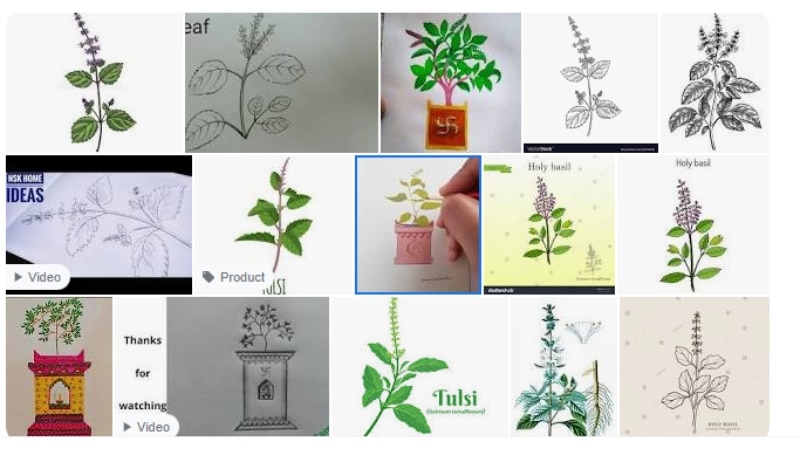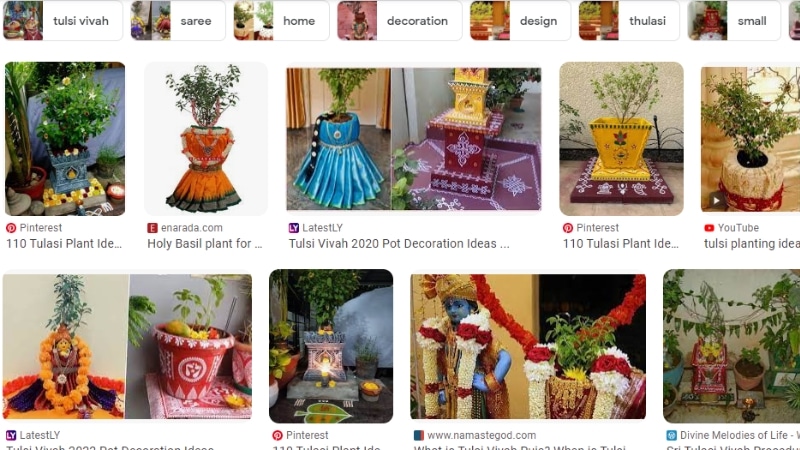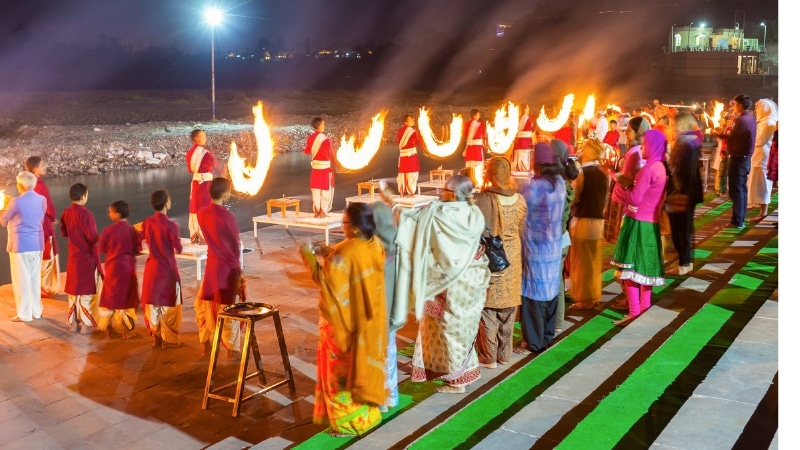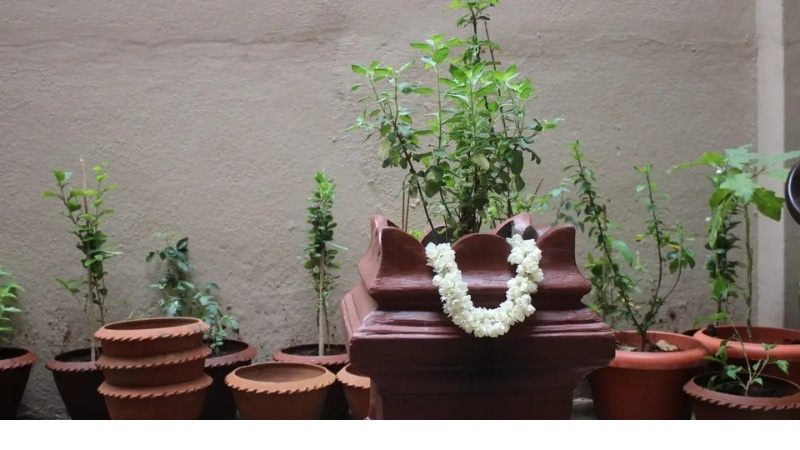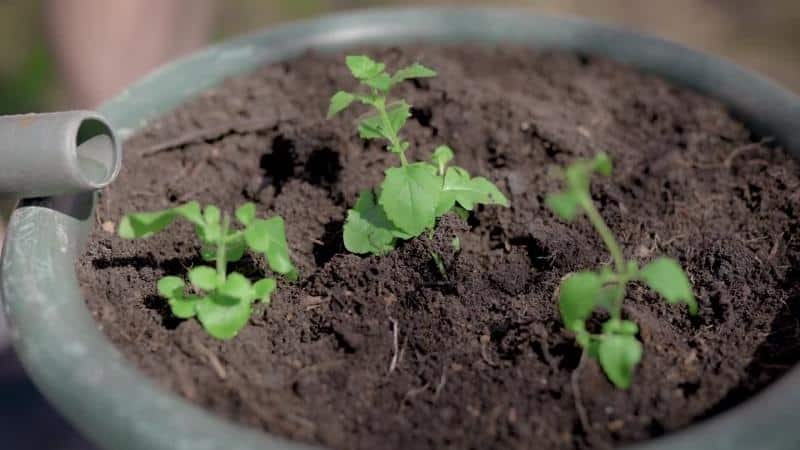Tulsi Vivah images depict the ceremonial marriage of the holy basil plant, Tulsi, with Lord Vishnu or his avatar, Lord Krishna. This auspicious event takes place during the Hindu month of Kartik and signifies the union of a devotee’s soul with the divine.
Read more:
It is believed that participating in or witnessing Tulsi Vivah blesses devotees with happiness, prosperity, and a happy married life. The images showcase the grandeur and beauty of the wedding rituals, including the intricately decorated Tulsi plant, colorful flowers, lamps, and Lord Vishnu’s idol.
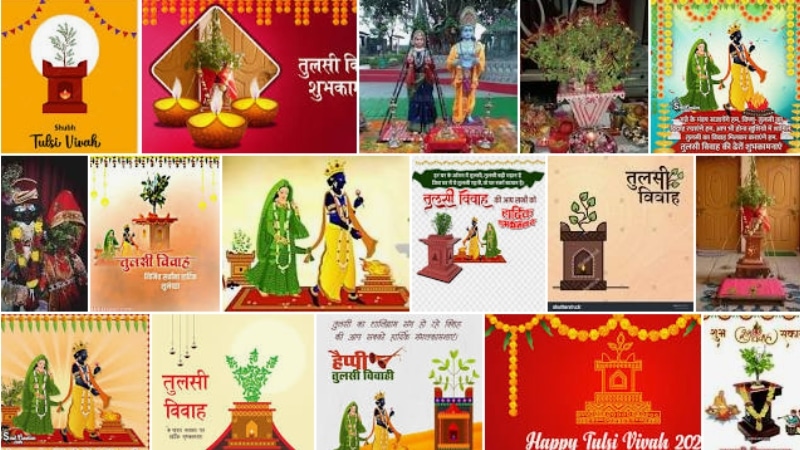
These images play a significant role in spreading awareness about the religious and cultural significance of Tulsi Vivah and its associated traditions.
The Significance Of Tulsi Vivah
Tulsi Vivah holds great significance in Hindu culture, as it symbolizes the ceremonial marriage of the Tulsi plant to Lord Vishnu. Explore captivating Tulsi Vivah images that depict the divine union and embrace the spiritual essence of this sacred ritual.
In Hindu culture, Tulsi Vivah holds great significance and is celebrated with joy and devotion. This ceremony involves the symbolic marriage of the Tulsi plant, also known as Holy Basil, with Lord Vishnu. It marks the beginning of the wedding season in India and is observed with enthusiasm in various parts of the country.
Let’s explore the symbolism and traditions associated with Tulsi Vivah, as well as its importance in Hindu mythology.
Symbolism And Traditions Associated With Tulsi Vivah:
- Marriage of Divinity and Nature: Tulsi Vivah signifies the sacred union of Lord Vishnu, the preserver of the universe, and Tulsi, considered the living embodiment of the goddess Lakshmi. It represents the harmonious relationship between divinity and nature.
- Importance of Tulsi: The Tulsi plant is revered for its medicinal and spiritual qualities. It is believed to ward off negative energies, purify the surroundings, and bring prosperity and good fortune. Tulsi Vivah celebrates the divine qualities of the Tulsi plant and its association with Lord Vishnu.
- Sacred Ritual: The ceremony of Tulsi Vivah is performed with great devotion and adherence to certain rituals. A Tulsi plant is decorated as a bride, adorned with ornate clothes, jewelry, and flowers. A clay image or picture of Lord Vishnu, in the form of his avatar, Rama or Krishna, is placed beside the Tulsi plant.
- Wedding Celebration: The wedding rituals mimic those of a traditional Hindu marriage. The Tulsi plant is symbolically married to Lord Vishnu through the chanting of mantras and the exchange of garlands. The marriage ceremony is witnessed by family members, friends, and the community, creating a festive atmosphere.
- Prayers and Offerings: Devotees offer prayers, perform aarti (ritual of waving a lamp), and offer water, vermilion, and sweets to the Tulsi plant and Lord Vishnu. These offerings express love, respect, and gratitude towards the divine couple.
Importance Of Tulsi Vivah In Hindu Mythology:
- Spiritual Benefits: Tulsi Vivah is considered highly auspicious and is believed to bestow spiritual blessings. It is believed that participating in the ceremony and observing the rituals with devotion can bring purity of mind, body, and soul.
- Ecological Significance: Tulsi Vivah highlights the importance of nature and the environment in Hindu culture. The Tulsi plant, known for its air-purifying properties, serves as a reminder of the need to protect and conserve nature.
- Fertility and Prosperity: The wedding of Tulsi and Lord Vishnu is believed to promote fertility, marital harmony, and prosperity in households. It is often seen as a prayer for the well-being and abundance of the family.
- Seasonal Transition: Tulsi Vivah marks the transition from the monsoon season to the wedding season in India. It is considered an auspicious time for marriages and symbolizes the beginning of joyful celebrations.
- Cultural Significance: Tulsi Vivah showcases the rich cultural heritage of India and strengthens familial and community bonds through collective participation in the wedding celebrations.
Tulsi Vivah holds great cultural and spiritual significance, emphasizing the sacred relationship between divinity and nature. The celebration of this auspicious ceremony brings joy, prosperity, and a deep sense of connection with the divine.
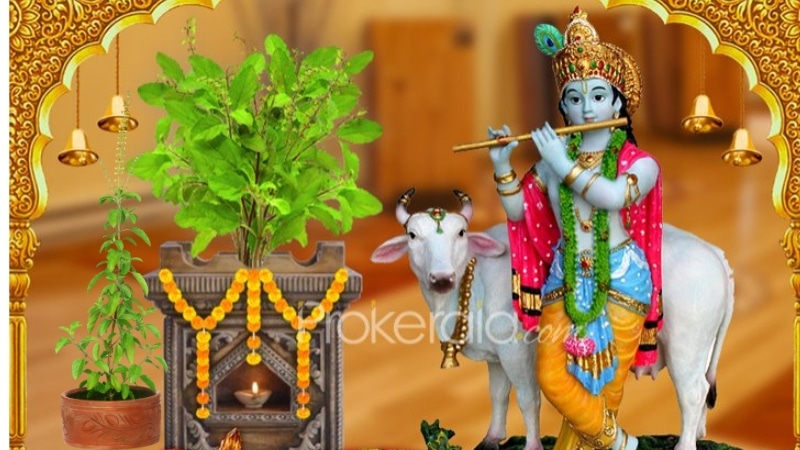
Legends And Stories
Tulsi Vivah Images showcase the grandeur and divine union of Lord Vishnu and Goddess Tulsi. Immerse yourself in the enchanting legends and stories surrounding this auspicious event through captivating visuals. Experience the blissful union of religious symbolism and artistic creativity.
The celebration of Tulsi Vivah is steeped in legends and stories that are deeply rooted in Hindu mythology. This divine union between Lord Vishnu and Tulsi, the holy basil plant, is not just a marriage of two souls but also symbolizes the bond between human beings and plants.
Let’s dive into the enchanting tales of love and devotion associated with Tulsi Vivah:
Tales Of Love And Devotion In Tulsi Vivah
- Legend 1: Tulsi’s devotion to Lord Vishnu: Tulsi, also known as Vrinda, was a devoted worshiper of Lord Vishnu. Her unwavering faith and dedication earned her a special place in the eyes of the Lord. It is believed that she was reborn as the holy basil plant due to a curse but retained her love and devotion for Lord Vishnu.
- Legend 2: Lord Vishnu’s test of devotion: Lord Vishnu, in the form of an enchanting prince, decided to test Tulsi’s devotion. He approached her but she recognized him as the Lord and refused his advances, explaining her loyalty to her divine consort. Impressed by her steadfastness, Lord Vishnu revealed his true form, and they united in love and marriage.
- Legend 3: The transformation of Tulsi: In another compelling story, Tulsi was cursed by Lord Shiva’s wife, Parvati, for neglecting her marital duties. The curse turned Tulsi into a plant and condemned her to keep wandering aimlessly. However, Lord Vishnu promised to marry her every year on the day of Tulsi Vivah, breaking the curse and granting her eternal companionship.
- Legend 4: Blessings of Tulsi Vivah: It is believed that those who witness or participate in the marriage ceremony of Lord Vishnu and Tulsi receive blessings for a prosperous and harmonious married life. Tulsi leaves are considered sacred and are used in various religious rituals and Ayurvedic remedies.
These captivating tales of love, devotion, and divine unions add depth and significance to the celebration of Tulsi Vivah. They remind us of the power of faith, loyalty, and the eternal bond between humans and nature. Let us immerse ourselves in the enchanting world of Tulsi Vivah and embrace the blessings it brings.
Preparations And Rituals
Discover the enchanting Tulsi Vivah Images capturing the beauty and significance of the preparations and rituals. Immerse yourself in the vibrant colors and intricate details of this auspicious ceremony. Experience the divine connection through these captivating images.
Tulsi Vivah is a significant Hindu festival that celebrates the sacred marriage ceremony of Tulsi, the holy basil plant, with Lord Vishnu. This auspicious occasion is observed with great devotion and joy by Hindu households across the country. The preparations and rituals leading up to the Tulsi Vivah ceremony hold deep cultural and religious significance.
Let’s explore the traditional preparations and step-by-step guide to conducting the rituals:
Traditional Preparations For Tulsi Vivah:
- Cleaning and decorating the Tulsi plant: Before the festival, the Tulsi plant is thoroughly cleaned and beautifully decorated with colorful flowers, betel leaves, and ornaments. It is believed that adorning the Tulsi plant attracts positive energy and blessings.
- Setting up the marriage mandap (canopy): A small canopy or mandap is crafted around the Tulsi plant using banana leaves or cloth. This represents the sacred space where the wedding rituals will take place.
- Arranging the wedding essentials: Various items like vermilion (sindoor), sacred thread (mangalsutra), turmeric powder (haldi), rice, and flowers are arranged to perform the wedding rituals. These essentials hold symbolic importance and are integral to the ceremony.
Step-By-Step Guide To Conducting The Rituals:
- Prayers and invocation: The ceremony begins with an invocation to Lord Vishnu and seeking his blessings for a successful marriage. Devotees gather around the Tulsi plant, chanting mantras and prayers to start the auspicious event.
- Lighting the lamp: A lamp, often made from cow dung, is lit near the Tulsi plant. The light represents the presence of divinity and illuminates the path towards a harmonious marriage.
- Offering water: Devotees offer water to Lord Vishnu and Tulsi as a symbol of purification and seeking their blessings. It is believed that this act brings health, prosperity, and marital bliss.
- The Vivah (marriage) ceremony: The bride (Tulsi) is dressed in colorful attire and adorned with jewelry. The groom (Lord Vishnu) is represented by a brass or clay idol. The marriage rituals are performed with utmost devotion, including the exchange of garlands, chanting of mantras, and tying the sacred thread (mangalsutra) around the Tulsi plant.
More info
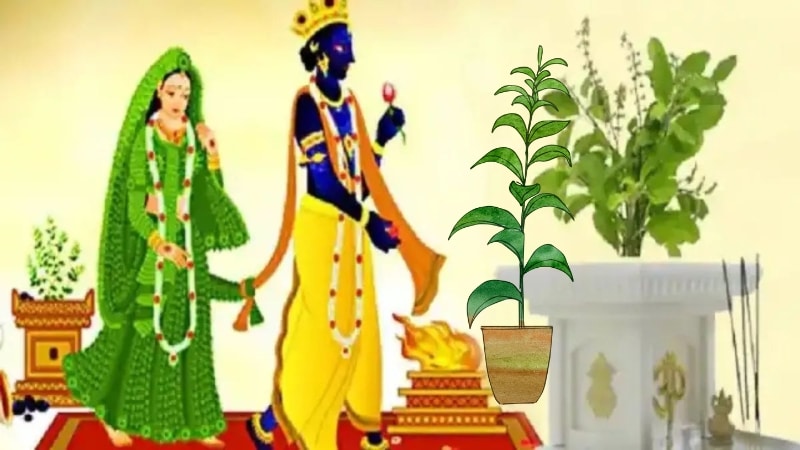
- Fasting and feasting: Many devotees observe a fast on Tulsi Vivah day, offering food only after the auspicious ceremony. Post-ceremony, a delicious feast is prepared and shared with family and friends, symbolizing joy and abundance.
- Distribution of Prasadam: Prasadam (blessed food) is distributed among the devotees as a token of divine blessings. It is considered auspicious to consume the Prasadam after the ceremony.
- Continuous worship: Following the Tulsi Vivah ceremony, devotees continue to worship and care for the Tulsi plant. Regular prayers, rituals, and offering water are part of the daily routine to maintain blessings and positive energy.
Tulsi Vivah is a beautiful celebration that signifies the divine union of Tulsi and Lord Vishnu. The preparations and rituals associated with this festival bring together families and communities, fostering a sense of unity and devotion. By actively participating in the traditional preparations and following the step-by-step guide for conducting the rituals, devotees invite blessings and divine grace into their lives.
Captivating Moments Of The Ceremony
Experience the captivating moments of the Tulsi Vivah ceremony through stunning images that beautifully showcase the sacred rituals and joyous celebrations. Immerse yourself in the vibrant colors, intricate decorations, and heartfelt emotions captured in these photographs.
Beautiful Decorations And Arrangements
Tulsi Vivah is a beautiful ceremony celebrated in Hindu culture, which marks the ceremonial marriage of the holy Tulsi plant (also known as the sacred basil) to Lord Vishnu. The auspicious occasion is filled with captivating moments that are a feast for the eyes.
Let’s explore the stunning decorations and arrangements that make Tulsi Vivah an enchanting affair:
- Elaborate mandaps: The marriage ceremony takes place under beautifully decorated mandaps, which are adorned with vibrant flowers, leaves, and traditional motifs. These intricately crafted structures create a mesmerizing backdrop for the sacred union.
- Floral adornments: The Tulsi plant itself is decked up with delicate flower garlands, giving it a resplendent and divine appearance. The entire surroundings are filled with the fragrance of fresh flowers, creating a heavenly ambiance.
- Colorful rangoli: Intricate rangoli designs are created at the entrance of the house or in the courtyard to welcome the divine couple. These colorful patterns add a festive touch and symbolize purity and prosperity.
- Elegant lighting: The entire venue is lit up with shimmering lights, diyas (earthen lamps), and decorative lanterns. This illuminates the atmosphere and adds a magical glow to the ceremony, enhancing its charm.
Rituals And Ceremonies During Tulsi Vivah
Tulsi Vivah is not just about the decorations; it involves a series of rituals and ceremonies that hold immense significance in Hindu culture. Let’s explore the rituals performed during this auspicious occasion:
- Muhurat ceremony: The chosen auspicious day and time for the wedding are determined through muhurat (astrological calculations). This is a crucial step to ensure the harmonious union of Tulsi and Lord Vishnu.
- Vivah Pujan: The ceremony begins with the Vivah Pujan, where the Tulsi plant is bathed, followed by the chanting of mantras and offering of flowers, incense, and sacred water. This ritual is performed to seek the blessings of the divine entities.
- Kanyadaan: The bride, represented by the Tulsi plant, is offered as a gift to Lord Vishnu. Kanyadaan, a ritual of giving away the bride, is performed by the devotees with great devotion and reverence.
- Garland exchange: As part of the ceremony, the garlands are exchanged between Tulsi and Lord Vishnu’s idol. This symbolic act signifies the acceptance of the marriage proposal and the beginning of a lifelong bond.
- Aarti: The ceremony concludes with the offering of aarti (ceremonial lamps) to Tulsi and Lord Vishnu. Devotees sing hymns and circulate the aarti lamps, spreading positive energy and seeking divine blessings.
Tulsi Vivah is an enchanting celebration that encompasses beautiful decorations and rituals, creating a mesmerizing atmosphere filled with spiritual fervor. It is a time when devotees come together to witness the captivating moments of this divine union, celebrating the sacred bond between Tulsi and Lord Vishnu.

Tulsi Vivah Celebrations Across India
Tulsi Vivah celebrations are a delightful part of Indian culture, and there are captivating images capturing this auspicious event in various regions. These images showcase the beauty, devotion, and vibrant traditions associated with Tulsi Vivah across India.
Tulsi Vivah, also known as Tulsi marriage, is a sacred Hindu festival celebrated across India with great enthusiasm and devotion. This festival marks the ceremonial marriage of the Tulsi plant (holy basil) to Lord Vishnu. It commonly takes place during the month of Kartik (October-November), on the day of Ekadashi.
Let’s explore the regional variations and unique customs of Tulsi Vivah celebrations across different states in India.
Regional Variations And Unique Customs:
- North India:
- In Uttar Pradesh and Bihar, people celebrate Tulsi Vivah by preparing a miniature shrine dedicated to Lord Vishnu and Tulsi. The festival is observed with religious rituals, recitation of hymns, and the exchanging of sweets among family members.
- In Rajasthan, the bride Tulsi plant is beautifully decorated with traditional ornaments and a grand wedding procession is taken out, complete with music and dance. The ceremony is followed by a grand feast for all the attendees.
- West India:
- In Maharashtra, Tulsi Vivah is celebrated with the reading of the marriage story of Tulsi and Lord Vishnu (Tulsi Vivah Katha). Devotees often create clay idols of the deities and perform the marriage rituals with great devotion.
More info
- In Gujarat, a sacred thread is tied around the Tulsi plant, symbolizing the marital bond. Devotees also light lamps and chant prayers throughout the night, seeking the blessings of Lord Vishnu and Goddess Lakshmi.
- South India:
- In Karnataka, Tulsi Vivah is celebrated by performing a wedding ceremony between Tulsi and Lord Vishnu. The wedding rituals are accompanied by the chanting of mantras and the showering of flowers and rice on the divine couple.
- In Tamil Nadu, devotees believe that a Tulsi plant in their homes can purify the surroundings. On the day of Tulsi Vivah, they perform special prayers and rituals along with the lighting of lamps to seek blessings for a prosperous life.
- East India:
- In Odisha, Tulsi Vivah is celebrated with great devotion. Devotees decorate the Tulsi plant, offer prayers, and perform the wedding ceremony with full traditional customs. The festival is followed by cultural performances and distribution of prasad (holy food) to everyone.
- In West Bengal, Tulsi Vivah is celebrated as a part of the holy festival of Kartik Puja. Devotees fast on this day and observe the marriage rituals of Tulsi and Lord Vishnu with great reverence.
Notable Celebrations In Different States:
- Uttar Pradesh:
- The state sees elaborate decorations of Tulsi plants, and devotees offer prayers and perform the wedding rituals with utmost devotion.
- Maharashtra:
- The Tulsi Vivah celebration includes the recitation of Tulsi Vivah Katha, followed by performing the wedding rituals between Tulsi and Lord Vishnu.
- Gujarat:
- Devotees tie a sacred thread around the Tulsi plant and light lamps to seek the blessings of Lord Vishnu and Goddess Lakshmi.
- Karnataka:
- The Tulsi Vivah ceremony incorporates the chanting of mantras, showering flowers, and rice on the divine couple, symbolizing their marriage.
- Odisha:
- Devotees perform the wedding ceremony of Tulsi with Lord Vishnu with full traditional customs and rituals. Cultural performances and prasad distribution are also part of the celebrations.
Tulsi Vivah holds immense significance in the Hindu religion and is celebrated with fervor in different states of India. Each region adds its own unique customs and variations to this auspicious festival, making it a truly remarkable celebration of divine love and union.
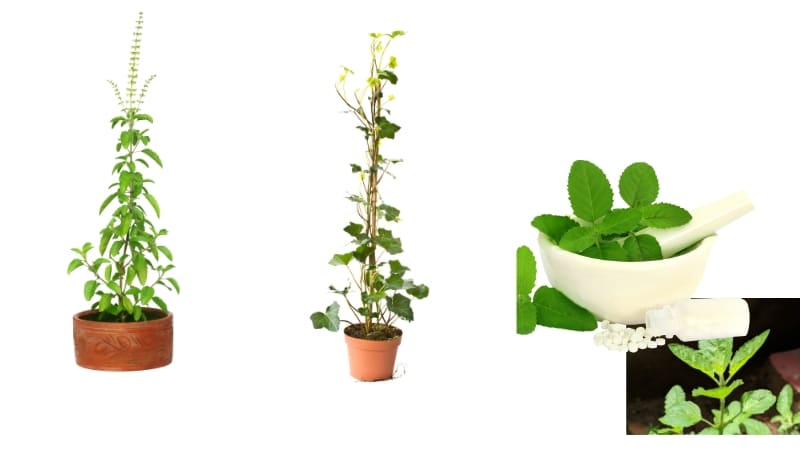
The Role Of Tulsi In Hindu Culture
Tulsi holds a significant role in Hindu culture, particularly in Tulsi Vivah ceremonies. Explore the beauty of Tulsi Vivah through captivating images that showcase the rich traditions and symbolism associated with this sacred union.
Tulsi, also known as the Holy Basil, holds immense importance in Hindu culture. Its significance goes beyond being a sacred plant and extends into various aspects of spiritual and daily life. Let’s delve into the spiritual and medicinal properties of Tulsi, as well as its ritualistic and cultural importance.
Spiritual And Medicinal Properties Of Tulsi:
Tulsi is renowned for its spiritual and medicinal properties. Here are some key points to understand its significance:
- A symbol of purity: Tulsi is considered a pure plant, often associated with the goddess Lakshmi. It is believed to cleanse the surroundings and purify the soul.
- Promotes overall well-being: Tulsi is widely recognized for its medicinal value. Its leaves possess healing properties and are used in ayurvedic remedies to treat various ailments such as cough, cold, headache, respiratory disorders, and more.
- Enhances spiritual practices: In Hinduism, Tulsi is considered a sacred plant that aids in spiritual practices. It is believed to attract positive energy and foster divine connections.
- Ward off negativity: Tulsi is believed to repel negative energies and evil spirits. Hence, it is often planted near homes or used in religious ceremonies for protection.
- Promotes mental clarity: The aroma of Tulsi leaves is known to provide a calming effect on the mind, reducing stress and anxiety. It helps in enhancing focus during meditation and other spiritual practices.
Ritualistic And Cultural Importance Of Tulsi Plant:
The Tulsi plant holds great ritualistic and cultural significance within Hinduism. Here are some noteworthy aspects to be aware of:
- Worship and rituals: Tulsi is revered and worshipped as a sacred plant in Hindu households. It is common to find Tulsi plants in a dedicated space within the house or in the courtyard, where daily prayers and rituals take place.
- The marriage of Tulsi: The festival of Tulsi Vivah celebrates the symbolic marriage of Tulsi plant to Lord Vishnu. It usually takes place during the Hindu month of Kartik (October-November) and is considered highly auspicious.
- Festive adornment: During festivals and celebrations like Diwali, Tulsi plants are decorated with lights, flowers, and ornaments. This practice adds vibrancy and auspiciousness to the festivities.
- Sacred herb in Ayurveda: Tulsi’s healing properties have made it an integral part of Ayurvedic medicine. Its leaves are often consumed raw or used for preparing herbal teas, providing numerous health benefits.
- Cultural traditions: Tulsi is an integral part of various cultural traditions in India. Its leaves are used in the preparation of holy water (Tulsi water) for religious rituals, and its presence marks the sanctity of the space.
Tulsi’s spiritual essence and cultural significance hold a profound place in Hindu culture. From its spiritual and medicinal properties to its ritualistic importance, Tulsi continues to shape the lives and traditions of millions of people, promoting well-being and fostering connection with the divine.
Conclusion
Tulsi Vivah Images celebrate the sacred union of Lord Vishnu and Goddess Tulsi. This auspicious festival marks the beginning of the wedding season in India, where devotees create beautiful mandaps and decorate them with vibrant flowers and dazzling lights. The significance of Tulsi Vivah can be seen in the belief that it blesses married couples with a harmonious and blissful relationship.
The images capture the essence of this divine union, portraying Lord Vishnu and Goddess Tulsi in their resplendent forms. These images not only serve as a visual delight but also hold immense spiritual value, reminding us of the divine connections in our lives.
Through these pictures, we can immerse ourselves in the devotion and religious fervor associated with Tulsi Vivah. So, embrace the beauty and grace of these Tulsi Vivah Images, and let them spread joy and positivity in your life.

